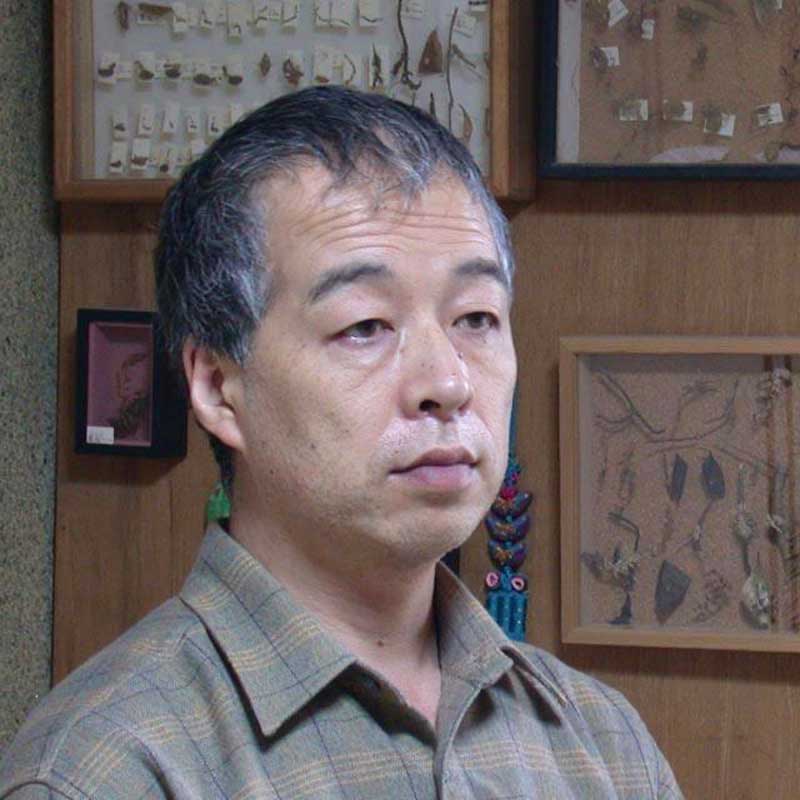1955年出生于日本神户,1974年进入日本京都市立艺术大学美术系,1976年加入油画壁画班,在山添耕治的指导下学习湿壁画(affresco)与蛋彩画。得益于当时京都艺大对意大利早期文艺复兴的热忱形成的风潮,追随前辈的脚步,大竹茂夫自1976—78年,在欧洲进行了为期两年的游学之旅,后分别在1979年和1981年获得了京都艺大的学士学位和研究生学位,毕业后作为日本文化厅的国内艺术家研修员,师从前田常作。
自1982年以来,他多次在东京、京都、神户等地举办个展与群展,拥有忠实的粉丝群体。2009年,他于日本电视台NHK纪录片节目「热忱时光:百忙之中有爱好/冬虫夏草篇」中出演,以一名对冬虫夏草充满热情的画家给观众留下了深刻印象。作为日本虫草菌同好会中的一员,他参与了2012年于日本石田大成社发行的《冬虫夏草的文化志》的编撰,该著作由奥沢康正主导,使用了大量大竹茂夫在京都实地采集的真菌照片。
1980年代的日本一度被视为是亚洲出版的旗帜。大量的欧洲文学涌入日本市场,1988年大竹茂夫与科幻出版巨头早川书房合作,此后十余年他的绘画作品被作为数本,美国著名儿童教育家桃莉·海顿(Torey L. Hayden)文学作品日译本的封面。2000年和2005年,与作家天沼春树合作,由帕罗舍出版了绘本《爱丽丝之国》和《小红帽》,大竹茂夫对“爱丽丝梦游仙境”和“小红帽”和这两个经典文学母题进行了连续的绘画创作。在《爱丽丝之国》中,大竹茂夫绘制了非同凡响、充满奇特生物的城市迷宫。
在人类历史中,人们一直被由几种生物所复合的怪物所吸引,比如古希腊神话中的飞马,奇美拉(拥有狮子的头,山羊的身躯,蟒蛇的尾巴),美人鱼,日本神话中的妖怪鵺(拥有猴子的脸、浣熊的身躯、老虎的四肢与蟒蛇的尾巴)…大竹茂夫绘画世界的「居民」与日常生活混杂一处,又隐于现实。他的创作最初由自然界昆虫和海栖动物启发,1985年在工作室所在区域挖出一株蝉花虫草,被菌丝寄生的蝉幼虫身体中冒出未完全成熟的子实体,将大竹茂夫从可食用真菌引入更为奇特的虫草世界。被真菌感染的蝉、蜘蛛等幼虫覆盖了人形,在他的作品中轮番登场。
叙事性是大竹茂夫创作中极为明显的特征,对某一主题的连续创作伴随着启示或寓言的短句。自上世纪八十年代至今,大竹茂夫在京都西部山区,对虫草菌进行了近四十年的采集和研究,他绘画中的「居民」也被真菌散发的孢子所侵染。“移动真菌园”“菌生代”与“真菌塔罗牌”以不同的面向呈现着这个王国的内在结构。“移动真菌园”描绘了真菌进入城镇与人类文明融合共生的进程;“菌生代”借鉴了但丁《神曲》之《地狱篇》的叙事方式,表现未来被真菌统治世界的画卷,充满警示意味;“真菌塔罗牌”将纸牌的角色属性与真菌的特征相互贯通,呈现出不可思议的交融。
Born in Kobe, Japan, in 1955. In 1974, Shigeo Otake enrolled in the Department of Fine Arts at Kyoto City University of Arts and joined the oil and mural painting class in 1976, studying fresco and tempera painting under Koji Yamazoe. Having benefited from the trend created by the enthusiasm of his school for the early Italian Renaissance at that time, following his predecessors, Otake embarked on a two-year journey in Europe, especially in Italy and Spain, from 1976 to 1978. He later received his bachelor’s and graduate degrees from Kyoto University of Arts in 1979 and 1981, respectively, and after graduation, he worked as a domestic artist researcher for Japan’s Agency for Cultural Affairs under the mentorship of Jōsaku Maeda.
Since 1982, Otake has had many solo and group exhibitions in Tokyo, Kyoto, and Kobe and has a devoted audience. In 2009, he appeared in the “Cordyceps” episode of Japanese network NHK’s documentary program “Time for Enthusiasm: hobbies in the busy time,” leaving a great impression on the audience as a painter with a passion for Cordyceps. A member of the Japanese Society of Cordyceps, he participated in the editing and preparation of Cultural History of Vegetable Wasp & Plant Worms, published by Ishida Taiseisha in 2012. Mainly edited by Yasumasa Okuzawa, this book features numerous photos of the fungus collected by Otake on-site in Kyoto.
Japan in the 1980s was once regarded as the epitome of publishing in Asia when a significant amount of European literature flooded into the Japanese market. In 1988, Shigeo Otake collaborated with the science fiction giant Hayakawa Publishing, and for more than a decade since, his paintings have been featured on the covers of several volumes of Japanese translations of the literary works of renowned American educator Torey L. Hayden. In 2000 and 2005, in collaboration with author Haruki Amanuma, he published children’s books Alicetopia and Little Red Riding Hood by Parol-sha, in which Otake illustrated the classical literary motifs of “Alice in Wonderland” and “Little Red Riding Hood”. In Alicetopia, Otake painted a fascinating urban maze full of strange creatures.
Throughout human history, people have been attracted to strange creatures hybrid with several kinds of species, such as the Pegasus in ancient Greek mythology, the Chimera (with the fore part of a lion, in the hinder a serpent, and in the midst a goat), the mermaid, and the Nue (with the head of a monkey, the limbs of a tiger, the body of a Japanese raccoon dog and the front half of a snake for a tail) in Japanese mythology. The inhabitants of Shigeo Otake’s world of paintings are intertwined with everyday life and concealed from reality. His practice was first inspired by insects and sea creatures. In 1985, he dug up a cicada Cordyceps in the yard of his studio; the immature sporocarp emerged from the body of the cicada larvae parasitized by mycelium, which drew the artist from the edible fungus to the more bizarre world of Cordyceps. Cicadas, spiders and other larvae infected by the fungus enclose the human form, making appearances in his work in turn.
教育 Education:
1976 加入油画壁画班
1974 进入日本京都市立艺术大学美术系
群展 Group Exhibition:


